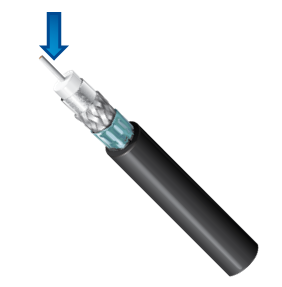Coax Cabling for 4K UHD HDBase T Applications Part 1
Many thought it would be impossible to design a cable to transmit a 4K UHD 12GHz video signal on a single coaxial cable. In 2016, Belden designed the first cable that does just that. Upon first glance it’s hard to see what makes this cable different. It still looks like a coaxial cable. But what happens underneath the cable jacket is what truly makes a difference.
The picture below represents the new 4K coax cable design. It looks pretty much like every other coax cable, doesn’t it? But it isn’t! There are five factors that set this new 4K coax cable design apart –four are outlined here for you and our next post will deep dive into the last factor.
1. Silver-Coated Copper Center Conductors

It’s easy to compare Belden’s new 4K coax cable design to other coax cables. Simply compare them side by side. Strip off the jacket, foil, braid and dielectric, and examine the conductor. The center conductor looks different– it’s not even copper colored. Instead, it is silver-coated copper. Silver is the best conductor; using it reduces the resistance for all signals and is especially effective for those high frequency signals that ride on the skin. Because of “skin effect”, it is important to make sure the conductor’s surface is as perfect as possible. In all our digital video cables, the surface of the center conductor has a mirror finish. In this 4K cable, it is a silver layer with a mirror finish.
2. A Mix of Plastic and Air Bubbles
Over the silver-coated copper conductor is the insulation – more appropriately called the “dielectric.” In a coaxial cable, the dielectric is made of a combination of plastic and air bubbles (nitrogen, actually – much more precise than regular old air). Known as “nitrogen-gas-injected foam polyethylene,” the amount of nitrogen impacts the speed of the signal traveling down the cable, called Velocity of Propagation (“Vp”)
It may seem like adding air would result in a soft plastic (and it might if you don’t know how to do gas injection). But the result in Belden’s factories is actually a hard material. This keeps the center conductor in the center of the dielectric, essentially for maintaining the impedance of the cable (For video coax, the impedance is 75 ohms.) A soft and squishy material would mean that the manufacturer doesn’t know how to make “gas-injected foam” very well. This hard material is called “high-density hard-cell nitrogen gas-inject foam.” If you’re comparing cables, simply squeeze the dielectric of each cable with your fingers.

3. New Type of Polyethylene
Another notable change in Belden’s 4K coax cable design is a new kind of polyethylene (the world’s most common plastic). There are hundreds of varieties of polyethylene, all offering different performance and price levels. The polyethylene used in these new cables offers significantly lower loss than previous types. As far as we know, this is the first time this type of polyethylene has been used in video cable.
4. Foil Shields Bonded to the Core
 Together, the center conductor and the dielectric over it make up the cable “core.” Over the core is a foil shield. In the past, this first foil shield has been left loose, wrapped around the plastic core. But the new 4K coax cable design bonds the foil to the core. With one-piece BNC connectors, the loose foil can bunch up as you push it on, making for a very bad connection. With bonded foil, “bunching up” is not possible. Further, the bonded foil stabilizes this foil layer so it cannot move. This stabilizes the impedance of the cable, which is determine by the distance from the center conductor to that foil layer.
Together, the center conductor and the dielectric over it make up the cable “core.” Over the core is a foil shield. In the past, this first foil shield has been left loose, wrapped around the plastic core. But the new 4K coax cable design bonds the foil to the core. With one-piece BNC connectors, the loose foil can bunch up as you push it on, making for a very bad connection. With bonded foil, “bunching up” is not possible. Further, the bonded foil stabilizes this foil layer so it cannot move. This stabilizes the impedance of the cable, which is determine by the distance from the center conductor to that foil layer.
The BNC slips right on, making a fast connector even faster.
Belden’s 4K Coax Cable
Belden’s new cable 4K coax cable has only two things in common with its predecessors.
First, both versions are the same size. This was accomplished by maintaining the same Vp at 83%. Keeping the same dimensions as the previous version allows existing connectors to be used with this new cable.
Second, the cables have a common PVC jacket. The print legend is different, of course, since the new cable is marked “12 GHz 4K UHD.” But that is where the commonality stops!
In my next post, I’ll offer more detail about the revolution of 4K coax cable design, including how the braiding process and design impact cable performance at 12 GHz, and the addition of a second foil shield. Subscribe to our blog to make sure you don’t miss it! If you have questions or suggestions, fill out the form below – or contact me directly at steve.lampen@belden.com..
![System.String[]](https://assets.belden.com/transform/03fc9f76-3aac-4627-9fbd-756f31cab5bc/steve-lampen?io=transform:fill,width:300,height:300)